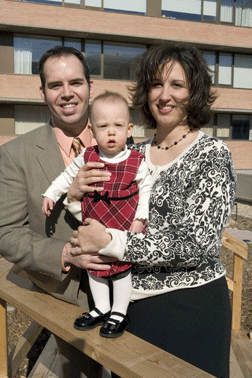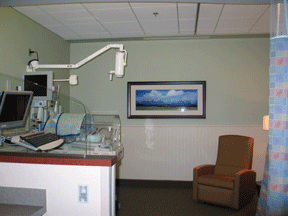 |
Ryan and Abby Saunders with daughter, Ava. |
Her brother had other plans.
Griffin was born in July — 13 weeks early and weighing only 2 lbs. 2 oz. He spent 79 days in the newborn intensive care unit (NICU) at The Nebraska Medical Center before going home. Today, he weighs 8 lbs.
“For all the things the NICU steals from you, it gives you something in return – a different perspective of what it means to be a parent,” said Ryan Saunders, father of Griffin and Ava, who was born 16 weeks premature at 1 lb. 2 oz. in 2004.
The NICU rollercoaster ride introduces you to “amazing people,” he said, recognizing David Bolam, M.D., medical director of the NICU, and the NICU nursing staff.
On Nov. 16, the NICU in the new Hixson-Lied Center for Clinical Excellence will officially open to the hospital’s tiniest patients. Located on the building’s top floor, the NICU cares for premature and sick infants and their families.
 The 34-bed unit, which includes private patient rooms and dedicated in-room family areas, will provide them with a more nurturing, healing environment and temporary home, which centers on the family as a partner in the care of their baby.
The 34-bed unit, which includes private patient rooms and dedicated in-room family areas, will provide them with a more nurturing, healing environment and temporary home, which centers on the family as a partner in the care of their baby.
“Each baby – each family – will have their own room,” said Chris Overfelt, manager of the new unit. “That’s so important because families need to bond with their newborn in the NICU just like they do at home. We can take care of a baby’s medical needs, but there’s no one like a mom or dad to take care of their baby’s emotional needs.”
The new unit — the only NICU in the region designated as Level III C that provides extracorporeal membrane oxygenation (ECMO) — has everything needed to support the developing brain of a premature infant, which is affected by light and noise.
Each private patient room in the new unit measures 175 to 180 square feet, which exceeds the minimum recommended standard of 150 feet. In addition, the new unit features: adjustable, indirect lighting in each room that can be cycled to replicate day-night rhythms; acoustic materials for ceilings, walls and floors to keep sound at 50 to 70 decibels; state-of-the-art technology that includes wireless communication; bedside electronic medical record documentation; and family Internet access.
“This unit is 20,000-square-feet and the other one was 5,000,” said Susan Adams, director of Women’s and Infants’ Services at The Nebraska Medical Center. “So you can tell just by the sheer size of it how much we were probably missing in terms of what was needed.”
 The additional space includes a dedicated sibling area, parent resource library, education room and lactation areas, as well as two overnight-care-by-parent rooms, to help parents transition from the hospital to home.
The additional space includes a dedicated sibling area, parent resource library, education room and lactation areas, as well as two overnight-care-by-parent rooms, to help parents transition from the hospital to home.
Nearby is the Rooftop Garden, which provides an outdoor oasis for families. The lobby, which features a lifelike tree beneath twinkling stars, is surrounded by children’s artwork.
To further enhance the connection between health and nature, also known as biophilia, the private NICU units feature landscapes and wildlife photos by Thomas Mangelsen. Studies have shown that people who watch images of natural landscapes after a stressful experience calm markedly in only a few minutes.
The goal was to reduce all the extraneous noise and control lighting and make it an individual room instead of a large auditorium-type intensive care unit so that it would be family-friendly, said Dr. Bolam, whose daughter, Rebecca, produced a special CD titled “Branches of Life” in honor of the NICU opening.